投资项目评价第二版答案_中国人民大学出版社
- 格式:pdf
- 大小:218.53 KB
- 文档页数:10
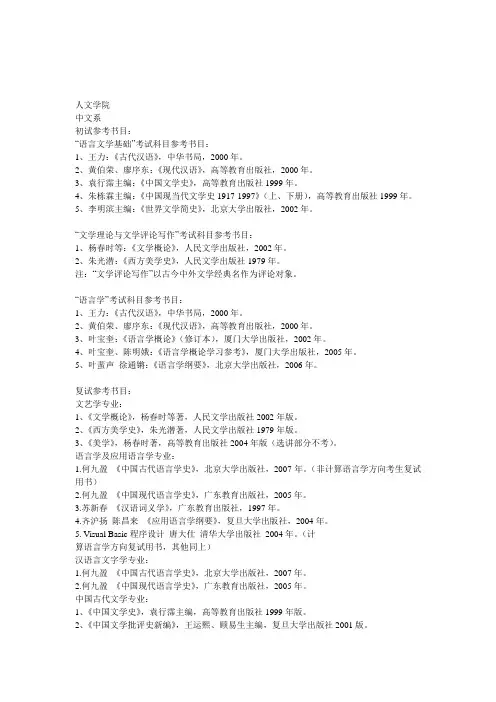

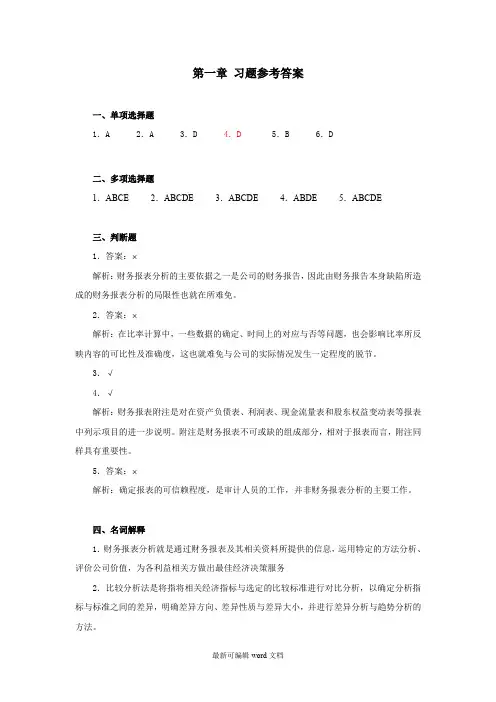
第一章习题参考答案一、单项选择题1.A 2.A 3.D 4.D 5.B 6.D二、多项选择题1.ABCE 2.ABCDE 3.ABCDE 4.ABDE 5.ABCDE三、判断题1.答案:⨯解析:财务报表分析的主要依据之一是公司的财务报告,因此由财务报告本身缺陷所造成的财务报表分析的局限性也就在所难免。
2.答案:⨯解析:在比率计算中,一些数据的确定、时间上的对应与否等问题,也会影响比率所反映内容的可比性及准确度,这也就难免与公司的实际情况发生一定程度的脱节。
3.√4.√解析:财务报表附注是对在资产负债表、利润表、现金流量表和股东权益变动表等报表中列示项目的进一步说明。
附注是财务报表不可或缺的组成部分,相对于报表而言,附注同样具有重要性。
5.答案:⨯解析:确定报表的可信赖程度,是审计人员的工作,并非财务报表分析的主要工作。
四、名词解释1.财务报表分析就是通过财务报表及其相关资料所提供的信息,运用特定的方法分析、评价公司价值,为各利益相关方做出最佳经济决策服务2.比较分析法是将指将相关经济指标与选定的比较标准进行对比分析,以确定分析指标与标准之间的差异,明确差异方向、差异性质与差异大小,并进行差异分析与趋势分析的方法。
3.因素分析法是通过分析影响财务指标的各项因素,并计算其对指标的影响程度,用以说明本期实际与计划或基期相比,财务指标发生变动或差异的主要原因的一种分析方法。
五、简述题1.财务报表分析功能主要有以下四个方面:(1)通过财务报表分析评估公司价值,保护投资者利益。
(2)通过财务报表分析评估信用风险,保护债权人利益。
(3)通过财务报表分析评价公司经营管理状况,改善公司管理。
(4)通过财务报表分析发现公司舞弊及其他风险,强化公司外部监管。
2.财务报表分析的原则为:实事求是原则、系统性原则、因果关系与平衡关系原则、定性分析与定量分析结合原则及动态分析原则。
3.由于财务报表分析的主要依据之一是公司的财务报告,因此由财务报告本身缺陷所造成的财务报表分析的局限性也就在所难免。

《投资学》教学大纲课程编号:1515P0016 课程类型: 专业选修课课程名称:投资学英文名称: Investments学分:2.5 适用专业:财务管理、会计学第一部分大纲说明一、课程教学性质、目的和任务本课程属于财务管理、会计学专业必修课。
本课程的目的:通过学习使学生具备较强的分析和解决投资决策的能力,满足投资实践的需求,提高投资效率,科学地进行投资决策。
有投资就有风险,要让学生同时认识投资的风险及分析方法,了解必要的风险控制方法。
本课程的任务:使学生在已修财务管理和会计学课程的基础上,了解:投资的基本原理、方法等知识,了解投资的类型、投资与经济发展的关系、投资体制、投资结构,必要的风险控制方法;熟悉:证券、证券市场、与证券定价原理;产业投资的市场分析、供给因素分析;掌握:证券投资的组合管理,也即评估方法;产业投资的效益分析,投资结构周期规律;应用这些理论与方法进行投资的实用技能,满足投资实践的需求。
二、课程的基本要求1、知识要求系统学习项目投资融资一般方法和实行途径,能力要求:通过学习拓展知识结构,具有对金融风险识别、化解、采取对策的初步能力。
了解:项目可行性研究、投资经济效果评价、项目多目标综合评价、风险决策、资产评估和项目融资的理论;熟悉:投资经济效果评价、项目多目标综合评价、风险决策方法;掌握:投资效果评价、风险决策理论与方法在项目投资和融资决策中的应用以及证券定价原理、证券投资的组合管理方法。
2、能力要求通过运用多种教学方法和形式组织教学,在充分了解和掌握项目投资与融资基本理论、基本知识和基本技能的基础上,达到解决投资与融资一般问题的能力。
3、措施方法:通过知识要点讲解、案例分析、作业布置与检查、要点回顾巩固、考试、查阅相关资料等,以实现对学生知识能力的考查和考核。
三、课程与相关课程的联系先修课程要求:《经济学》、《会计学》、《财务管理》、《统计学》、《企业管理》等。
《项目投资与融资决策》这门学科的运用及相关知识较广,一般涉及数学、会计学、财务管理、统计学、财政学、银行管理、企业管理、市场营销、国际贸易、生产运营管理等学科的理论知识。
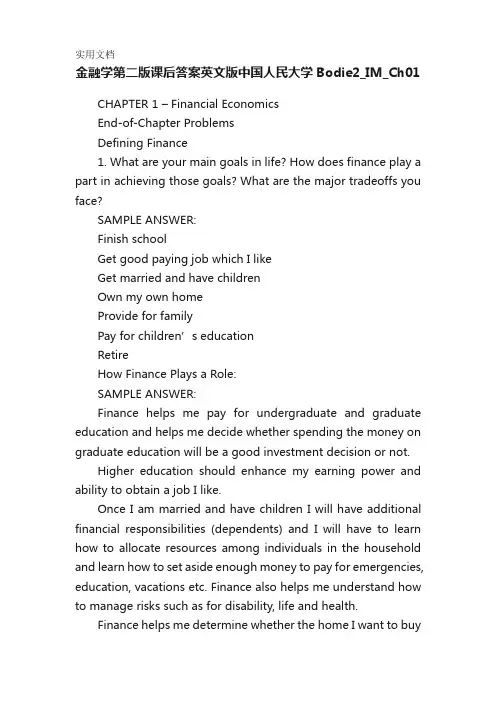
金融学第二版课后答案英文版中国人民大学Bodie2_IM_Ch01CHAPTER 1 – Financial EconomicsEnd-of-Chapter ProblemsDefining Finance1. What are your main goals in life? How does finance play a part in achieving those goals? What are the major tradeoffs you face?SAMPLE ANSWER:Finish schoolGet good paying job which I likeGet married and have childrenOwn my own homeProvide for familyPay for children’s educationRetireHow Finance Plays a Role:SAMPLE ANSWER:Finance helps me pay for undergraduate and graduate education and helps me decide whether spending the money on graduate education will be a good investment decision or not.Higher education should enhance my earning power and ability to obtain a job I like.Once I am married and have children I will have additional financial responsibilities (dependents) and I will have to learn how to allocate resources among individuals in the household and learn how to set aside enough money to pay for emergencies, education, vacations etc. Finance also helps me understand how to manage risks such as for disability, life and health.Finance helps me determine whether the home I want to buyis a good value or not. The study of finance also helps me determine the cheapest source of financing for the purchase of that home.Finance helps me determine how much money I will have to save in order to pay for my children’s education as well as my own retirement.Major Tradeoffs:SAMPLE ANSWERSpend money now by going to college (and possibly graduate school) but presumably make more money once I graduate due to my higher education.Consume now and have less money saved for future expenditures such as for a house and/or car or save more money now but consume less than some of my friendsFinancial Decisions of Households2. What is your net worth? What have you included among your assets and your liabilities? Would you list the value of your potential lifetime earning power as an asset or liability? How does it compare in value to other assets you have listed?SAMPLE ANSWER:$ ____________ (very possibly negative at this point)Assets:Checking account balanceSavings account balanceFurniture/Jewelry (watch)Car (possibly)Liabilities:Student loansCredit card balanceIf renting, remainder of rental agreement (unless sublettingis a possibility)Car payments (possibly)Students typically don’t think about the high value of their potential lifetime earning power when calculating their net worth but for young people it is often their most valuable asset.3. How are the financial decisions faced by a single person living alone different from those faced by the head of a household with responsibility for several children of school age? Are the tradeoffs they have to make different, or will they evaluate the tradeoffs differently?A single person needs only to support himself and therefore can make every financial decision on his own. If he does not want health insurance (and is willing to bear the financial risks associated with that decision) then no one will be affected by that decision other than that single person. In addition, this person needs to make no decisions about allocating income among dependents. A single person is very mobile and can choose to live almost anywhere. The tradeoffs this individual makes generally concern issues of consuming (or spending) today versus saving for consumption tomorrow. Since this person is supporting only himself, the need to save now is less important than for the head of household discussed next.T he head of household with several children must share resources (income) among dependents. This individual must be prepared to deal with risk management issues such as how to be prepared for potential financial emergencies (such as a serious health problem experienced by a member of the family or home owners insurance in case of a fire or other mishap). Because there are more people in this household than with a single person, there are greater risks that someone will get sick or injured. Andbecause there are dependents, the wage earner(s) should think carefully about life and disability insurance. In addition, the family is not as mobile as the single individual. Because of the school age children, the family might want to live near “good schools” thinking that a stronger education will eventually help those children’s future well being and financial situation. Thus, the tradeoffs for the head of household are more complex: more money is needed to consume today (he or she needs to support more dependents), but a lot more money is also needed to save for future expenses such as education and housing and more money is needed for risk management such as life and disability insurance.4. Family A and family B both consist of a father, mother and two children of school age. In family A both spouses have jobs outside the home and earn a combined income of $100,000 per year. In family B, only one spouse works outside the home and earns $100,000 per year. How do the financial circumstances and decisions faced by the two families differ?With two wage earners, there is less risk of a total loss of family income due to unemployment or disability than there is in a single wage earning household. The single wage earning family will probably want more disability and life insurance than the two wage earning family. On the flip side, however, the two wage earning family may need to spend extra money on child care expenses if they need to pay someone to watch the children after school.5. Suppose we define financial independence as the ability to engage in the four basic household financial decisions without resort to the use of relative’s resources when making financing decisions. At what age should children be expected to becomefinancially independent?Students will have differing responses to this question depending upon their specific experiences and opinions. Most will probably say independence should come after finishing their education, and they have a significant flow of income.6. You are thinking of buying a car. Analyze the decision by addressing the following issues:a.Are there are other ways to satisfy your transportation requirements besides buying a car? Make a list ofall the alternatives and write down the pros and cons.Transportation Mode Pros ConsWalking ?Takes you directly where you wantto goNo out of pocket costsConvenient ?Takes a long time ?Destination may be too far Bicycle ?Takes you directly to where youwant to goNo out of pocket marginal costsConvenient ?Requires physical strength and endurance ?Destination may be too farBus ?InexpensiveReaches more distant destinations ?May not take you directly where you want to go ?Inconvenient schedules to go ?Many stops, not efficientSubway ?InexpensiveFast ?May not take you directly where you want to goLocal destinations only on limited networkTrain ?Reaches distant destinations ?Moderately expensiveMay not take you directly whereyou want to goAirplane ?Reaches distant destinationsFast ?Most expensiveWill not take you directly where you want to gob. What are the different ways you can finance the purchase of a car?F inance through a bank loan or lease, finance through a car dealer with a loan or a lease or finance the car out of your own savings.c. Obtain information from at least three different providers of automobile financing on the terms they offer.d. What criteria should you use in making your decision?Your decision will be to select the financing alternative that has the lowest cost to you.When analyzing the information, you should consider the following:Do you have the cash saved to make an outright purchase? What interest rate would you be giving up to make that purchase? Do you pay a different price for the car if you pay cash rather than finance?For differing loan plans, what is the down payment today? What are the monthly payments? For how long? What is the relevant interest rate you will be paying? Does the whole loan get paid through monthly payments or is there a balloon payment at the end? Are taxes and/or insurance payments included in the monthly payments? ?For differing lease plans, what is the down payment today? What are the monthly payments? For how long? Do you own the car at the end of the lease? If not, what does it cost to buy the car? Do you have to buy the car at the end of the lease or is it an option? Is there a charge if you decide not to buy the car? What relevant interest rate will you be paying? Are taxesand/or insurance payments included in the monthly payments? Are there mileage restrictions?7. Match each of the following examples with one of the four categories of basic types of household financial decisions.At the Safeway paying with your debit card rather than taking the time to write a checkDeciding to take the proceeds from your winning lottery ticket and use it to pay for an extended vacation on the Italian RivieraFollowing Hillary’s advice and selling your Microsoft shares to invest in pork belly futuresHelping your 15-year old son learn to drive by letting putting him behind the wheel on the back road into townTaking up the offer from the pool supply company to pay off your new hot tub with a 15-month loan with zero payments for the first three monthsThe first is the most difficult since in practice it is simply a cash transaction involving no financing. As such the purchase is a consumption decision only and the payment choice is not a financing decision. The second is also a consumption/saving decision. The third is an exchange of one financial asset for another and therefore an investment decision. The fourth is a risk-management decision since you have subjected yourself to increased risk that is not covered by insurance. The final example is a financing decision involving a loan to finance a purchase.Forms of Business Organization8. You are thinking of starting your own business, but have no money.a.Think of a business that you could start without having to borrow any money.A ny business that involves a student’s own personal service would be cheap to start up. For instance he or she could start a business running errands for others, walking their dogs, shopping etc. Along those same lines they could start some kind of consulting business. Both of these businesses could be run out of their dorm room or their own home and could be started with very little capital. If they wanted to hire additional workers, they would have to be paid on a commission basis to limit upfront expenses.b. Now think of a business that you would want to start if you could borrow any amount of money at the going market interest rate.Certainly there are many interesting businesses that could be started if one could finance 100% of the business with borrowed capital and no equity. Since you will be able to borrow 100% of the financing, you will be willing to take a lot greater risk than if you were investing your own money.c. What are the risks you would face in this business?[Answer is, of course, dependent on answer to question “b.”]d. Where can you get financing for your new business?Depending upon the size of the financing needed, students should be looking for both debt and equity financing. The sources of this financing ranges from individuals and credit cards (for very small sums) to banks, venture capitalists, public debt and equity markets, insurance companies and pension funds9. Choose an organization that is not a firm, such as a club or church group and list the most important financial decisions it has to make. What are the key tradeoffs the organization faces? What role do preferences play in choosing among alternatives?Interview the financial manager of the organization and check to see if he or she agrees with you.SAMPLE ANSWER:Local Church group. Most important financial decisions:Whether or not to repair damage done to church and grounds during last big hurricane (specifically repairing the leaking roof)What project to put off in order to pay for repair damageHow to pay for renovations to downstairs Sunday school roomsHow to increase member attendance and contributionsHow to organize and solicit volunteers for the annual Church Sale (largest fund raiser of the year)Key Tradeoffs and Preferences:C hurch group funds are severely limited, so the organization needs to prioritize expenses based upon cost and need. Not all projects that are needed will be undertaken due to the expense involved. An equally large amount of timewill be spent trying to raise financing since funds inflow is variable. Since not all projects can be financed, preferences of different important individuals (such as the pastor) take on great significance in the decision-making process.Market Discipline: Takeovers10. Challenge Question: While there are clear advantages to the separation of management from ownership of business enterprises, there is also a fundamental disadvantage in that it may be costly to align the goals of management with those of the owners. Suggest at least two methods, other than the takeover market, by which the conflict can be reduced, albeit at some cost.One way is to provide incentives for the managers so that they increase their pay when owners interests are improved. An example would be compensating managers with stock options, the value of which increase with the market value of shareholder’s int erests. A second method is to more closely monitor the behavior of the managers. Outside management consultants and auditors serve this role in part particularly to the extent that they report their findings to representatives from ownership groups. Both of these solutions assume the management cannot effectively deceive markets or consultant/auditors through misleading information or actions to inflate the market value of the ownership shares or there performance records.11. Challenge Question:Consider a poorly run local coffee shop with its prime location featuring a steady stream of potential clients passing by on their way to and from campus. How does the longtime disgruntled, sloppy and inefficient owner-manager of Cup-a-Joe survive and avoid disciplining from the takeover market? This is not a question about a misalignment of the goals of the owner(s) and manager(s) of a firm since we have explicitly said the firm is owner-managed. If in fact the coffee shop is mismanaged the potential exists for an outsider to purchase a controlling interest in the operation and put more efficient management into place if the purchase price does not exceed the value of profits to be generated by the efficiently managed firm. If the present owner chooses not to sell he must value the firm for more than the value of the profits generated by an efficiently managed firm. Therefore his position in the firm must generate for him non-pecuniary benefits, or benefits unrelated to the firm’s profitability and he is therefore not avalue maximizer. Perhaps he enjoys making fun of his clients or takes pride in his eclectic tastes in interior decorating. In any case the takeover market does discipline him in the sense that he will be forced to pay for his non-pecuniary benefits in the sense that he trades off profits.The same could be said of an owner-manager who lacks the required specialized skills to properly run the firm but never the less continues to operate the company inefficiently because he ‘likes’ the work!The Role of the Finance Specialist in a Corporation12. Which of the following tasks undertaken within a corporate office are likely to fall under the supervision of the treasurer? The controller?Arranging to extend a line of credit from a bankArranging with an investment bank for a foreign exchange transactionProducing a detailed analysis of the cost structure of the company’s alternative product linesTaking cash payments for company sales and purchasing U.S. Treasury BillsFiling quarterly statements with the Securities and Exchange CommissionThe first two and the fourth items are responsibilities of the treasurer while the third and fifth items fall under the workload of the controller’s office.Objectivesy Define finance.y Explain why finance is worth studying.y Introduce two of the main players in the world of finance—households and firms—and the kinds of financial decisions theymake. The other main players, financial intermediaries and government, are introduced in chapter 2.Contents1.1Defining Finance1.2Why Study Finance?1.3Financial Decisions of Households1.4Financial Decisions of Firms1.5Forms of Business Organization1.6Separation of Ownership and Management1.7The Goal of Management1.8Market Discipline: Takeovers1.9The Role of the Finance Specialist in a CorporationSummaryFinance is the study of how to allocate scarce resources over time. The two features that distinguish finance are that the costs and benefits of financial decisions are spread out over time and are usually not known with certainty in advance by either the decision maker or anybody else.A basic tenet of finance is that the ultimate function of the system is to satisfy people’s consumption preferences. Economic organizations such as firms and governments exist in order to facilitate the achievement of that ultimate function. Many financial decisions can be made strictly on the basis of improving the trade-offs available to people without knowledge of their consumption preferences.There are at least five good reasons to study finance:y To manage your personal resources.y To deal with the world of business.y To pursue interesting and rewarding career opportunities.y To make informed public choices as a citizen.y To expand your mind.The players in finance theory are households, business firms, financial intermediaries, and governments. Households occupy a special place in the theory because the ultimate function of the system is to satisfy the preferences of people, and the theory treats those preferences as given. Finance theory explains household behavior as an attempt to satisfy those preferences. The behavior of firms is viewed from the perspective of how it affects the welfare of households.Households face four basic types of financial decisions:y Saving decisions: How much of their current income should they save for the future?y Investment decisions: How should they invest the money they have saved?y Financing decisions: When and how should they use other people’s money to sa tisfy their wants and needs?y Risk-management decisions: How and on what terms should they seek to reduce the economic uncertainties they face or to take calculated risks?There are three main areas of financial decision making in a business: capital budgeting, capital structure, and working capital management.There are five reasons for separating the management from the ownership of a business enterprise: y Professional managers may be found who have a superior ability to run the business.y To achieve the efficient scale of a business the resources of many households may have to be pooled.y In an uncertain economic environment, owners will want to diversify their risks across many firms. Such efficient diversification is difficult to achieve without separation ofownership and management.y To achieve savings in the costs of gathering information.y The “learning curve” or “going concern” effect: When the owner is also the manager, the new owner has to learn the business from the former owner in order to manage it efficiently. If the owner is not the manager, then when the business is sold, the manager continues in place and works for the new owner.The corporate form is especially well suited to the separation of ownership and management of firms because it allows relatively frequent changes in owners by share transfer without affecting the operations of the firm.The primary goal of corporate management is to maximize shareholder wealth. It leads managers to make the same investment decisions that each of the individual owners would have made had they made the decisions themselves.A competitive stock market imposes a strong discipline on managers to take actions to maximize the market value of the firm’s shares.。
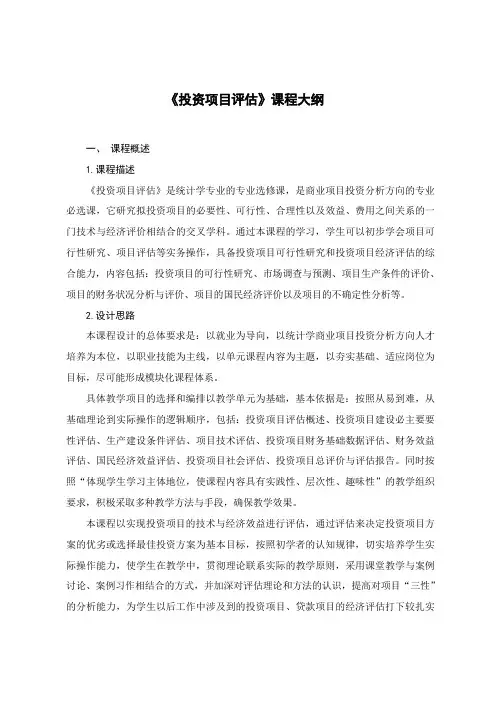
《投资项目评估》课程大纲一、课程概述1.课程描述《投资项目评估》是统计学专业的专业选修课,是商业项目投资分析方向的专业必选课,它研究拟投资项目的必要性、可行性、合理性以及效益、费用之间关系的一门技术与经济评价相结合的交叉学科。
通过本课程的学习,学生可以初步学会项目可行性研究、项目评估等实务操作,具备投资项目可行性研究和投资项目经济评估的综合能力,内容包括:投资项目的可行性研究、市场调查与预测、项目生产条件的评价、项目的财务状况分析与评价、项目的国民经济评价以及项目的不确定性分析等。
2.设计思路本课程设计的总体要求是:以就业为导向,以统计学商业项目投资分析方向人才培养为本位,以职业技能为主线,以单元课程内容为主题,以夯实基础、适应岗位为目标,尽可能形成模块化课程体系。
具体教学项目的选择和编排以教学单元为基础,基本依据是:按照从易到难,从基础理论到实际操作的逻辑顺序,包括:投资项目评估概述、投资项目建设必主要要性评估、生产建设条件评估、项目技术评估、投资项目财务基础数据评估、财务效益评估、国民经济效益评估、投资项目社会评估、投资项目总评价与评估报告。
同时按照“体现学生学习主体地位,使课程内容具有实践性、层次性、趣味性”的教学组织要求,积极采取多种教学方法与手段,确保教学效果。
本课程以实现投资项目的技术与经济效益进行评估,通过评估来决定投资项目方案的优劣或选择最佳投资方案为基本目标,按照初学者的认知规律,切实培养学生实际操作能力,使学生在教学中,贯彻理论联系实际的教学原则,采用课堂教学与案例讨论、案例习作相结合的方式,并加深对评估理论和方法的认识,提高对项目“三性”的分析能力,为学生以后工作中涉及到的投资项目、贷款项目的经济评估打下较扎实的基础。
3、本课程与专业人才培养目标的关系4. 本课程与其它课程的关系。
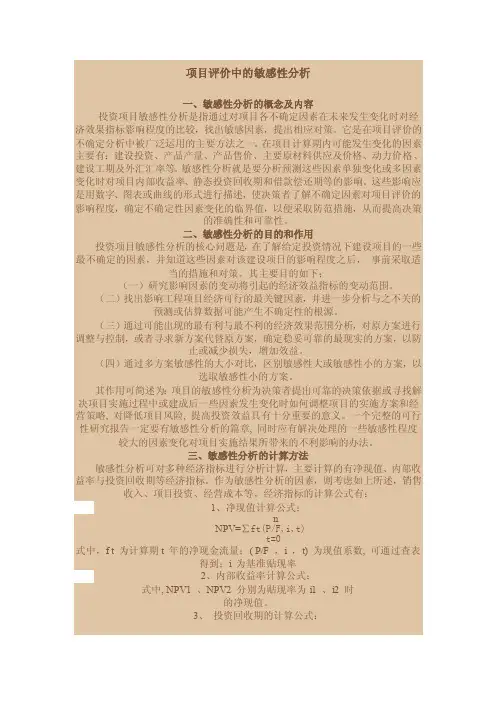
项目评价中的敏感性分析一、敏感性分析的概念及内容投资项目敏感性分析是指通过对项目各不确定因素在未来发生变化时对经济效果指标影响程度的比较,找出敏感因素,提出相应对策。
它是在项目评价的不确定分析中被广泛运用的主要方法之一。
在项目计算期内可能发生变化的因素主要有:建设投资、产品产量、产品售价、主要原材料供应及价格、动力价格、建设工期及外汇汇率等。
敏感性分析就是要分析预测这些因素单独变化或多因素变化时对项目内部收益率、静态投资回收期和借款偿还期等的影响。
这些影响应是用数字、图表或曲线的形式进行描述,使决策者了解不确定因素对项目评价的影响程度,确定不确定性因素变化的临界值,以便采取防范措施,从而提高决策的准确性和可靠性。
二、敏感性分析的目的和作用投资项目敏感性分析的核心问题是,在了解给定投资情况下建设项目的一些最不确定的因素,并知道这些因素对该建设项日的影响程度之后,事前采取适当的措施和对策。
其主要目的如下:(一)研究影响因素的变动将引起的经济效益指标的变动范围。
(二)找出影响工程项目经济可行的最关键因素,并进一步分析与之不关的预测或估算数据可能产生不确定性的根源。
(三)通过可能出现的最有利与最不利的经济效果范围分析,对原方案进行调整与控制,或者寻求新方案代替原方案,确定稳妥可靠的最现实的方案,以防止或减少损失,增加效益。
(四)通过多方案敏感性的大小对比,区别敏感性大或敏感性小的方案,以选取敏感性小的方案。
其作用可简述为:项目的敏感性分析为决策者提出可靠的决策依据或寻找解决项目实施过程中或建成后一些因素发生变化时如何调整项目的实施方案和经营策略, 对降低项目风险, 提高投资效益具有十分重要的意义。
一个完整的可行性研究报告一定要有敏感性分析的篇章, 同时应有解决处理的一些敏感性程度较大的因素变化对项目实施结果所带来的不利影响的办法。
三、敏感性分析的计算方法敏感性分析可对多种经济指标进行分析计算,主要计算的有净现值、内部收益率与投资回收期等经济指标。

人文学院中文系初试参考书目:“语言文学基础”考试科目参考书目:1、王力:《古代汉语》,中华书局,2000年。
2、黄伯荣、廖序东:《现代汉语》,高等教育出版社,2000年。
3、袁行霈主编:《中国文学史》,高等教育出版社1999年。
4、朱栋霖主编:《中国现当代文学史1917-1997》(上、下册),高等教育出版社1999年。
5、李明滨主编:《世界文学简史》,北京大学出版社,2002年。
“文学理论与文学评论写作”考试科目参考书目:1、杨春时等:《文学概论》,人民文学出版社,2002年。
2、朱光潜:《西方美学史》,人民文学出版社1979年。
注:“文学评论写作”以古今中外文学经典名作为评论对象。
“语言学”考试科目参考书目:1、王力:《古代汉语》,中华书局,2000年。
2、黄伯荣、廖序东:《现代汉语》,高等教育出版社,2000年。
3、叶宝奎:《语言学概论》(修订本),厦门大学出版社,2002年。
4、叶宝奎、陈明娥:《语言学概论学习参考》,厦门大学出版社,2005年。
5、叶蜚声徐通锵:《语言学纲要》,北京大学出版社,2006年。
复试参考书目:文艺学专业:1、《文学概论》,杨春时等著,人民文学出版社2002年版。
2、《西方美学史》,朱光潜著,人民文学出版社1979年版。
3、《美学》,杨春时著,高等教育出版社2004年版(选讲部分不考)。
语言学及应用语言学专业:1.何九盈《中国古代语言学史》,北京大学出版社,2007年。
(非计算语言学方向考生复试用书)2.何九盈《中国现代语言学史》,广东教育出版社,2005年。
3.苏新春《汉语词义学》,广东教育出版社,1997年。
4.齐沪扬陈昌来《应用语言学纲要》,复旦大学出版社,2004年。
5. Visual Basic程序设计唐大仕清华大学出版社2004年。
(计算语言学方向复试用书,其他同上)汉语言文字学专业:1.何九盈《中国古代语言学史》,北京大学出版社,2007年。
2.何九盈《中国现代语言学史》,广东教育出版社,2005年。
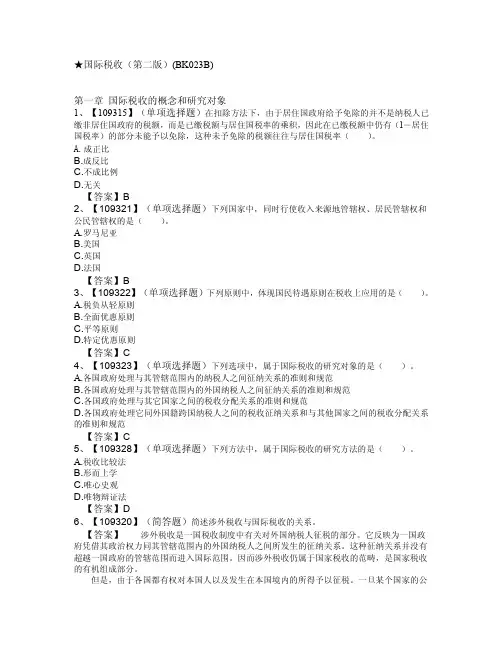
★国际税收(第二版)(BK023B)第一章国际税收的概念和研究对象1、【109315】(单项选择题)在扣除方法下,由于居住国政府给予免除的并不是纳税人已缴非居住国政府的税额,而是已缴税额与居住国税率的乘积,因此在已缴税额中仍有(1-居住国税率)的部分未能予以免除,这种未予免除的税额往往与居住国税率()。
A.成正比B.成反比C.不成比例D.无关【答案】B2、【109321】(单项选择题)下列国家中,同时行使收入来源地管辖权、居民管辖权和公民管辖权的是()。
A.罗马尼亚B.美国C.英国D.法国【答案】B3、【109322】(单项选择题)下列原则中,体现国民待遇原则在税收上应用的是()。
A.税负从轻原则B.全面优惠原则C.平等原则D.特定优惠原则【答案】C4、【109323】(单项选择题)下列选项中,属于国际税收的研究对象的是()。
A.各国政府处理与其管辖范围内的纳税人之间征纳关系的准则和规范B.各国政府处理与其管辖范围内的外国纳税人之间征纳关系的准则和规范C.各国政府处理与其它国家之间的税收分配关系的准则和规范D.各国政府处理它同外国籍跨国纳税人之间的税收征纳关系和与其他国家之间的税收分配关系的准则和规范【答案】C5、【109328】(单项选择题)下列方法中,属于国际税收的研究方法的是()。
A.税收比较法B.形而上学C.唯心史观D.唯物辩证法【答案】D6、【109320】(简答题)简述涉外税收与国际税收的关系。
【答案】涉外税收是一国税收制度中有关对外国纳税人征税的部分。
它反映为一国政府凭借其政治权力同其管辖范围内的外国纳税人之间所发生的征纳关系。
这种征纳关系并没有超越一国政府的管辖范围而进入国际范围。
因而涉外税收仍属于国家税收的范畴,是国家税收的有机组成部分。
但是,由于各国都有权对本国人以及发生在本国境内的所得予以征税。
一旦某个国家的公民或居民在国外从事经济活动,他都会有来自国外的所得或收入,外国政府也就有权向他征税,因而他就有可能面临被本国和外国两个国家征税的问题。
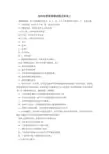
批判性思维逻辑试题及答案二逻辑推理题:从下面每题所列的A、B、C、D、E五个备选答案中选出一个,多选为错。
1、小张承诺:如果天不下雨,我一定去听音乐会。
以下哪项为真,说明小张没有兑现承诺?I天没下雨,小张没去听音乐会。
II天下雨,小张去听了音乐会。
III天下雨,小张没去听音乐会。
A、仅I。
B、仅II。
C、仅III。
D、仅I和II。
E、I、II和III。
2、我想说的都是真话,但真话我未必都说。
如果上述断定为真,则以下各都可能为真,除了A、我有时也说假话。
B、我不是想啥说啥。
C、有时说某些善意的假话并不背我的意愿。
D、我说的都是我想说的话。
E、我说的都是真话。
3、有些人若有一次厌食,会对这次膳食中有特殊味道的食物持续产生强烈厌恶,不管这种食物是否会对身体有利。
这种现象可以解释为什么小孩更易于对某些食物产生强烈的厌食。
以下哪项如果为真,最能加强上述解释?A、小孩的膳食搭配中含有特殊味道的食物比成年人多。
B、对未尝过的食物,成年人比小孩更容易产生抗拒心理。
C、小孩的嗅觉和味觉比成年人敏锐。
D、和成年人相比,小孩较为缺乏食物与健康的相关知识。
E、如果讨厌某种食物,小孩厌食的持续时间比成年人更长。
4、在桂林漓江一些有地下河流的岩洞中,有许多露出河流水面的石笋。
这些石笋是由水滴长年滴落在岩石表面而逐渐积聚的矿物质形成的。
如果上述断定为真,最能支持以下哪项结论?A、过去漓江的江面比现在高。
B、只有漓江的岩洞中才有地下河流。
C、漓江的岩洞中大都有地下河流。
D、上述岩洞中的地下河流是在石笋形成前出现的。
E、上述岩洞中地下河流的水比过去深。
5-6基于以下题干:一般认为,一个人80岁和他在30岁相比,理解和记忆能力都显著减退。
最近的一项调查显示,80岁的老人和30岁的年轻人在玩麻将时所表现出的理解和记忆能力没有明显差别。
因此,认为一个人到了80岁理解和记忆能力会显著减退的看法时站不住脚的。
5、以下哪项如果为真,最能消弱上述论证?A、玩麻将需要的主要不是理解和记忆能力。

《IT项目管理》题库考试复习题目录一、名词解释 (6)1、项目生命周期 (6)2、项目经理 (6)3、项目干系人 (6)4、项目章程 (6)5、项目目标 (7)6、项目需求 (7)7、泛项目 (7)8、项目管理知识领域 (7)9、项目管理成熟度模型 (7)10、PMBOK (8)11、项目过程组 (8)12、质量功能表 (8)13、净现值法 (8)14、里程碑 (9)15、多项目管理 (9)16、项目组织 (9)17、平衡矩阵型组织 (9)18、项目管理办公室 (10)19、范围管理 (10)20、范围说明书 (10)21、范围规划 (10)22、项目范围 (11)23、工作分解结构 (11)24、工作包 (11)25、范围核实 (11)26、活动定义 (11)27、甘特图 (12)28、责任分配矩阵 (12)30、前导图法(PDM) (12)31、计划评审技术(PERT) (12)32、关键线路法(CPM) (12)33、时间成本平衡法 (13)34、总时差 (13)35、挣值管理 (13)36、成本预算 (13)37、成本控制变更系统 (13)38、挣值(EV) (14)39、进度偏差(SV) (14)40、费用偏差(CV) (14)41、成本绩效指数(CPI) (14)42、项目质量 (14)43、质量保证 (14)44、质量控制 (15)45、PDCA循环 (15)46、鱼刺图 (15)47、帕累托图 (15)48、风险管理计划 (15)49、风险管理过程 (16)50、应急准备金 (16)51、管理准备金 (16)52、头脑风暴法 (16)53、风险定性分析 (16)54、风险应对策略 (16)55、风险 (17)56、总价合同 (17)57、成本补偿合同 (17)58、马斯洛需求层次理论 (17)59、X理论 (17)60、Y理论 (18)62、激励 (19)63、沟通管理过程 (19)64、沟通计划 (19)65、多项目管理 (20)66、大项目管理 (20)二、简答题 (20)1、简述IT项目管理的发展状况及目前主要的项目管理组织。
★纳税检查(第二版)(BK022B)第一章纳税检查导论1、【91384】(单项选择题)按照《征管法》规定,从事生产经营的纳税人应当自领取()或发生纳税义务之日起15日内设置账簿。
A.营业执照B.税务登记证C.法人代码证D.银行开户许可证【答案】A2、【91385】(单项选择题)纳税人未按规定的期限缴纳或者解缴税款的,税务机关除责令限期缴纳外,还可以从滞纳税款之日起按日加滞纳税款()的滞纳金。
A.1‰B.2‰C.5‰D.0.5‰【答案】D3、【91386】(单项选择题)调取账簿及有关资料应当填写《调取账簿资料通知书》、《调取账簿资料清单》,调取以前年度账的,应在()内完整退还。
A.1个月B.2个月C.3个月D.6个月【答案】C4、【91387】(单项选择题)税务行政处罚听证的范围是()。
A.对公民作出1 000元以上罚款的案件B.对公民作出2 000元以上罚款的案件,对法人或其他组织作出10 000元以上罚款的案件C.对法人或其他组织作出20 000元以上罚款的案件D.对法人或其他组织作出50 000元以上罚款的案件【答案】B5、【145475】(单项选择题)税务稽查包括选案、实施、审理、执行四个方面的工作环节,但从工作内容看,其核心是()。
A.选案和检查B.检查和处理C.审理和执行D.补税和罚款【答案】B6、【91388】(多项选择题)税务检查权是税务机关在检查活动中依法享有的权利,《税收征管法》规定税务机关有权()。
A.检查纳税人的账簿、记账凭证、报表和有关资料B.责成纳税人提供与纳税有关的文件、证明材料和有关资料C.到纳税人的生产、经营场所和货物存放地检查纳税人应纳税的商品、货物或者其他财产D.对纳税人的住宅及其他生活场所进行检查【答案】A,B,C7、【91389】(多项选择题)纳税人、扣缴义务人对税务机关作出的决定,享有()。
A.申辩权、陈述权B.申请行政复议的权利C.提请行政诉讼的权利D.请求国家赔偿的权利【答案】A,B,C,D8、【91390】(多项选择题)实施税务稽查应当二人以上,并出示()。
《项目评估》教学大纲一、课程基本信息课程名称:项目评估课程编号:课程类别:总学时:52总学分:适用专业:财务管理专业二、课程的性质与任务本课程是财务管理专业实践课程。
项目评估是会计学专业的专业方向课。
它研究拟投资项目的必要性、可行性、合理性以及效益、费用之间关系的一门技术与经济评价相结合的交叉学科。
其实质内容是对投资项目的技术与经济效益进行评估,通过评估来决定投资项目方案的优劣或选择最佳投资方案。
通过该课程的教学,使学生掌握投资项目的可行性研究、市场调查与预测、项目生产条件的评价、项目的财务状况分析与评价、项目的国民经济评价以及项目的不确定性分析等基本理论和评估方法,初步学会项目可行性研究、项目评估等实务操作,具备投资项目可行性研究和投资项目经济评估的综合能力。
三、课程教学目标在教学中,贯彻理论联系实际的教学原则,采用课堂教学与案例讨论、案例习作相结合的方式,并加深对评估理论和方法的认识,提高对项目“三性”的分析能力,为学生以后工作中涉及到的投资项目、贷款项目的经济评估打下较扎实的基础。
四、教学方法与手段理论讲授与课堂讨论相结合。
五、考核方式过程性考核包括:出勤30%,作业40%,课堂互动30%。
期末考试:闭卷。
过程性考核占总成绩的20%,期末考试占80%。
六、教学内容第一章总论(4学时)通过本章学习,学术应掌握项目评估的基本概念、原则、依据、内容和程序,重点掌握投资项目的定义和类型;熟悉投资的含义及其本质、作用与特征;了解项目评估与可行性研究的关系。
【教学内容】1、投资和投资项目 2、项目评估的产生和发展3、项目评估与可行性研究的关系4、项目评估的原则、依据、内容和程序【教学重点】本章教学的重点是项目评估的基本概念、原则、依据、内容和程序,投资项目的定义及类型。
【教学难点】本章教学的难点是理解投资项目的定义及类型【学时数】课堂讲述4学时第二章 投资项目概况与必要性评估(6学时)【教学目标】通过本章的学习,学生应掌握项目建设宏观必要性评估的内容,重点掌握项目建设微观必要性评估的内容;熟悉项目概况评估的基本概念;了解项目概况评估的主要内容和一般方法。
第五章习题参考答案6. CD 7・ ABC 8. ABCE 9. ABE三、判断题1. 答案:x解析:盈利能力分析主要分析正常情况下的盈利状况,因此,必须剔除非正常因索的影 响。
2. 答案:73. 答案:x解析:营业税金对企业而言属于不可控费用,可作为客观因素忽略其对销售净利率的彩 响。
4. 答案:75. 答案:x解析:市盈率是指普通股股票每股市价与每股收益之间的比率,即每股市价相当于每股 收益的倍数。
市净率反映了股价相当于每股净资产的倍数。
6. 答案:7解析:去年的资产净利率=5.73% x 2.17=12.43%今年的资产净利率=4.88% x 2.88=14.05%由于:净资产收益率二资产净利率x 权益乘数。
两年的资产负债率相同,即权益乘数不变。
因此,资产净利率提高,净资产收益率必然上升。
7. 答案:7 一、单项选择题1. A 2・ A3. A 4・ B 5. C6. B7. D8. C9. A 10. D二、多项选择题1. BD2. BCDE3. BCDE 4・ ABCD 5. ABCDE解析:因为利润总额中对能包含了非经常或非正常因素的影响,只有连续比鮫多年的总资产收益率,对其变动趋势进行判断,才能取得相对准确的判断。
8.答案:x解析:净资产收益率二销售净利率x总资产周转率x权益乘数。
销伟增长率大于净利增长率,则销售净利率下降。
总资产增长率人于销售增长率,则总资产周转率下降。
负债总额增长率小于资产增长率,则权益乘数下降。
销售净利率、总资产周转率和权益乘数三个比率同时下降,可判断净资产收益率比上年降低了。
9.答案:x解析:从股东的立场看,当资产收益率高于借款利息率时,负债比例越大越好,否则反之。
10.答案:7解析:每股收益=400/ (1000+500x9 / 12) =0.29 (元/股)四、名词解释1.盈利能力,是指公司赚取利润的能力,反映公司的资本增值能力。
2.销售毛利率,是指营业收入与营业成本的差额与营业收入之间的比率。
金融数学蔡明超答案【篇一:金融学书单】学,兹威博迪,罗伯特莫顿(中文版)2、asset pricing 2005, john h. cochrane3、dynamic asset pricing , duffie4、continuous-time finance robert c. merton6、the handbook of fixed income securities 7the,frank j. fabozzi7、investments--bodie, kane, marcus 5ed8、principle of financial engineering,salih n. neftci9、financial engineering and computation,yuh-dauh lyuu11、a benchmark of quantative finace,eckhard platen12、dynamic structure modeling,sanjay k. nawalkha13、numerical methods for finance,jhon a.d.appleby14、corporate fiance 6e,ross?westerfield?jaffe15、corporate finance-theory practice,pascal quiry maurizio dallocchio yann le fur antonio salvi16、the theory of corporate finance,jean tirole17、handbook of corporate finance1,william t. ziemba18、handbook of corporate finance2,william t. ziemba19、principles of corporate finance, seventhedition,brealey?meyers20、mergers, acquisitions and corporate restructuring,patricka. gaughan21、mergers, acquisitions and corporaterestructuring,chandrashekar krishnamurti vishwanath s.r.22、the economics of money,banking and financial markets,mishkin23、monetary economics,jagdish handa24、monetary theory and policy,carl e. walsh25、financial markets and institutions 5e,peter howells and keith bain26、handbook of finance financial markets and instruments - (2008),frank j. fabozzi27、microeconomics of banking 2e,xavier freixas and jean-charles rochet28、the economics of exchange rates,lucio sarno29、handbook of international banking 2003,andrew w. mullineux30、international finance--putting theory into practice,piet sercu31、advances in behavioral finance,richard h. thaler32、股市趋势技术分析33、资本市场的混沌与秩序(第二版)34、专业投机原理35、通向金融王国的自由之路36、非理性繁荣37、伟大的博弈38、国际金融钱荣堃南开大学出版社39、公司财务原理布雷利等著,方曙红等译,机械工业出版社40、投资学博迪、凯恩、马库斯著,陈收、杨艳译机械工业出版社41、货币银行学易纲、吴有昌著上海人民出版社42、财政学陈共著中国人民大学出版社43、本杰明-格雷厄姆:《证券分析》(securities analysis)44、理查斯-盖斯特:《金融体系中的投资银行》(investment banking in financial system)45、布鲁斯-格林威尔:《价值投资》(value investing)46、彼得-伯恩斯坦:《有效资产管理》(the intelligent asset allocater)47、理查德-费里:《指数基金》(all about index funds)48、大卫-史文森:《机构投资与基金管理的创新》(pioneering portfolio management)49、斯蒂芬-戴维斯:《银行并购:经验与教训》(bank mergers: lessons for the future)50、financial management and analysis, frank j.fabozzi51、货币金融学,米什金,中国人民大学出版社,199852、金融市场学,郑振龙,高等教育出版社53、资本市场的混沌与秩序,彼得斯,经济科学出版社,199954、finance, zvi bodie, robert c.merton,中国人民大学出版社,200055、货币、信用与商业,马歇尔56、资本市场:机构与工具,frank j.fabozzi,佛朗哥.莫地利安尼,经济科学出版社,2th,199857、the financial analyst’s handbook,sumner n.lenving58、资本理论及其收益率,罗伯特.索络,商务印书馆,199259、货币、银行与经济,托马斯.梅耶60、货币与资本市场,8th,peter.s.rose,中国人民大学出版社,200661、金融工具手册,frank.j.fabozzi,上海人民出版社,2006.762、金融体系:原理与组织,埃德温.尼夫,中国人民大学出版社,200563、管制、放松与重新管制,艾伦.加特,经济科学出版社,199964、corporate finance,rose,westerfield,5th edition, mcgraw-hill65、maximizing corporate value, george m.norton66、应用公司理财67、公司财务原理,布雷利迈尔斯,东北财经大学出版社68、现代企业财务管理,11th詹姆斯.c.范霍恩,经济科学出版社,200269、financial market and corporate strategy, glinbratt,70、时间序列分析预测与控制,george e.p box71、金融数学与分析技术,蔡明超72、计量经济模型与经济预测,平尼克.鲁宾费尔德,机械工业出版社73、金融数学,joseph stampfli,蔡明超译,机械工业出版社,2005.474、金融时间序列分析,ruey.s.tsay,机械工业出版社,2006.475、微观金融学及其数学基础,昭宇,清华大学出版社,2003.1176、计量经济分析方法与建模:eviews应用与及实例,高铁梅,清华大学出版社,200677、固定收益证券,布鲁斯.塔夫曼,科文(香港)出版社78、债券市场分析与战略,frank j.fabozzi79、全球金融市场的固定收益分析80、国际金融市场:价格与政策,2th,richard m.levich,机械工业出版社,200181、国际货币与金融,迈尔斯.梅尔文82、国际经济学,保罗.克鲁格曼,5th,中国人民大学出版社,200283、期权交易入门,e-book84、futures,forwards,options and swaps:theory and practice85、衍生产品,郑振龙,武汉大学出版社86、金融工程,约翰.马歇尔,维普尔.班赛尔,清华大学出版社,199887、financial risk manager handbook,philippe jorion88、米勒.莫顿论金融衍生工具,清华大学出版社,199989、asset-based finance,by citibank90、期权、期货与其他衍生产品,约翰.赫尔,3th,华夏出版社91、金融工程学,骆伦茨.格利茨,经济科学出版社92、金融工程学案例,斯科特.梅森,东北财经大学出版社,2001.493、options,futures other derivatives,fifth editon,hall94、投资圣经,沃伦.巴非特,台海出版社95、证券分析,本杰明.格雷汉姆,海南出版社,199596、资产选择-投资的有效分散化,哈里.马克维茨,经贸出版社97、投资学,威廉.夏普,中国人民大学出版社98、投资学,zvi bodie,6edition,机械工业出版社,2005.799、投资组合管理理论及应用,机械工业出版社100、金融心理学,拉斯.特维斯,中国人民大学出版社,2000101、格雷汉姆论价值投资102、新金融学:有效市场的反例,罗伯特.a.哈根,清华大学出版社,2002103、有效资产管理,威廉.波恩斯坦,上海财经大学出版社104、active equity portfolio management,frank j.fabozzi,上海财经大学出版社 105、微观银行学,哈维尔.佛雷克斯,西南财经大学出版社,1999106、handbook of international banking ,andrew w.mullineux 107、商业银行管理,5th,peter.s.rose,机械工业出版社,2004.8 108、银行信用风险分析手册,乔纳森.格林,机械工业出版社109、银行风险分析与管理,亨利.范.格罗,中国人民大学出版社110、银行资本管理:资本配置和绩效评测,克里斯.马腾,机械工业出版社,2004 111、银行管理-教程与案例,乔治.h.汉普尔,中国人民大学出版社,2002112、金融体系中的投资银行,查理斯.r.吉斯特,经济科学出版社 113、兼并与收购,中国人民大学出版社114、共同基金运作,阿尔伯特.j.弗里德曼,清华大学出版社,1998115、对冲基金手册(中文),拉托尼奥,mcgraw-hill,2000116、指数基金,richard.a.ferri, 上海财经大学出版社117、伟大的博弈-华尔街帝国的崛起,约翰.戈登,中信出版社118、项目融资(哈佛经典),华夏出版社119、新帕尔格雷夫经济学大辞典第一、二、三、四卷:a-z,约翰.伊特维尔,经济科学出版社,1996120、公司治理学,李维安,高等教育出版社,2005121、会计学教程与案例,10th,罗伯特.n.安东尼,大卫.f.霍金斯,机械工业出版社(mcgraw-hill),2002122、《证券分析》,本杰明.格雷汉姆,海南出版社,2006,70周年纪念版123、《股史风云话投资》(stocks for the long run),杰里米.西格尔,清华大学出版社,2004124、《投资者的未来》,杰里米.西格尔,机械工业出版社,2007 125、《与天为敌-风险探索传奇》,彼得.波恩斯坦,清华大学出版社126、《资产分配-投资者如何平衡金融风险》,罗杰.c.吉布森,机械工业出版社(mcgraw-hill),2006127、《漫步华尔街》,伯顿.麦基尔,上海财经大学出版社,2002 128、《巴比伦富翁的理财圣经》,乔治.克拉森,学林出版社,2005129、《怎样选择成长股》,菲利普.a.菲舍,海南出版社,2006130、《金融炼金术》,乔治.索罗斯,海南出版社,1999131、《个人理财》,杰克.r.卡普尔,上海人民出版社,2006132、《1929年大崩盘》,约翰.肯尼斯.加尔布雷斯,上海财经大学出版社,2006.10 133、《解读华尔街》,杰弗里.b.里特,上海财经大学出版社(mcgraw-hill),2006 134、《金融理财原理》(上下册)(fpscc考试指定用书),中信出版社,2007135、《聪明的投资者》,本杰明.格雷汉姆,江苏人民出版社136、《共同基金常识》,约翰.博格137、《伯格投资-聪明投资者的最好50年》,约翰.博格138、《散户至上-证交会主席教你避险并反击股市黑幕》,阿瑟.莱维特,中信出版社,2005 139、《金融法概论》第5版,吴志攀著,北京大学出版社2011年版。
《投资项目评估》教学大纲前言本课程是为适应学院培养“宽口径”、“厚基础”、“重能力”的经济管理专门人才而开设的一门专业课程,是天津财经学金融系的核心课程之一。
本课程修读对象为全系各本科专业学生。
改革开放以来,我国投融资体制发生了深刻变化,项目评估在投资决策的投资管理中的作用越来越大。
为适应我国加入WTO 之后进一步深化改革、扩大开放的新形势,促进投资主体决策科学化,提高投资效率,需要进一步强化项目评估工作,规范评估的内容与深度,提高评估质量。
本课程将介绍各投资主体和决策者均应熟悉和掌握的项目评估程序和方法,突出评估中的具体操作技术,包括企业财务评估、国民经济评估、不确定性评估方法与方案选优工具。
第一章是导论,介绍投资的三个阶段的关系;第二——五章阐述项目建设必要性评估;第六——八章属于技术评估,故而从略;第九——十五章是课程的核心,重点介绍项目评估的方法和原理。
本课程的先导课程是:西方经济学、会计学、财务管理《投资项目评估》教学大纲目录教学内容 (1)第一章导论 (1)第二章企业资信评估 (3)第三章项目概况和建设的必要性评估 (6)第四章市场分析和销售研究 (8)第五章项目规模评估 (10)第六章投资估算与资金筹措方案 (11)第七章国民经济评估 (13)第八章不确定性和风险分析 (15)第九章投资方案比较 (16)重点章节 (重要问题) (17)参考书目 (18)课时分配 (20)教学内容第一章导论教学要求:介绍项目评估在投资周期中的地位。
内容结构:第一节项目周期与投资决策程序一、项目和投资项目1项目2投资项目——非金融资产获得活动3以盈利为目的的一组任务二、项目周期1投资前期、中期和后期的划分2评估属于投资前期与中期的衔接步骤3评估对象是可行性研究报告三、可行性研究的工作步骤1机会发现2初步可行性研究3可行性研究4项目评估决策四、项目投资决策程序——由简入繁、由浅入深的过程1初步分析与项目建议书2立项、贷款计划、工程咨询和可行性研究3可行性研究报告评估和评估报告4最终拍板决策第二节可行性研究一、可行性研究的概念和作用1可行性研究的概念2作用——6个方面的依据二、可行性研究的内容1总论——综述项目概况2产品市场和拟建规模3资源、原材料供应与分用设备情况4建厂条件与厂址方案5项目工程技术6环保与劳保7生产组织、定员与人员培训8项目实施进度9经济效果分析10结论和建议二、可行性研究工作程序1项目建议书2业主委托有资格的单位进行可行性研究3设计单位进行可行性研究4经济分析评估5可行性研究报告第三节项目评估一、项目评估的要求1符合法律、法令2符合宏观规划3技术先进、宏观和微观有效益二、项目评估内容1建设必要性2建设的生产条件3工艺技术的先进和适用性4经济效益评估5评估三、可行性研究评估报告大纲四、可行性研究与项目评估的异同1可行性研究与项目评估共同点2可行性研究与项目评估的区别本章重点(重要问题):项目评估的要求项目评估内容可行性研究评估报告大纲可行性研究与项目评估的异同第二章企业资信评估教学要求:简介企业资信评估的内容和方法内容结构:第一节企业资信评估的目的和作用一、企业资信评估的概念和目的1.概念2.目的二、企业资信评估的意义和作用第二节企业资信评估的内容一、企业素质评估1.对企业领导群体和全体职工素质的评估2.产品素质评估3.技术装备素质评估4.资产素质评估5.管理素质评估6.企业行为评估二、企业信用评估1.企业信贷资金信用评估2.企业经济合同履约信用评估3.企业产品信誉评估三、经营管理评估四、企业经济效益评估五、企业发展前景评估第三节企业资信评估的度程序和方法一、企业资信评估的程序1.申请或委托企业资信评估2.收集和核查资料3.计算指标,编制报表4.综合评估,确定资信等级5.编写评估报告二、企业资信评估的方法1.定量分析和定性分析相结合2.静态分析和动态分析相结合3.综合分析评价法第四节企业资信评估指标的计算一、企业资产结构、素质评估指标1.资产负债率2.固定资产净值率3.流动比率4.速动比率5.长期资产与长期负债比率6.存货周转率7.应收账款周转率二、企业信用程度评估指标1.全部资金自有率2.定额量流动资金自有率3.流动资金贷款偿还率4.呆滞资金占压率5.贷款支付率6.贷款按期偿还率7.合同履约率三、企业经营管理评估指标1.产品销增长率2.一级品率3.新产品开发计划完成率4.产品销售率5.产品库存适销率6.全部流动资金周转加速率四、企业经济效益评估指标1.资金利税率2.销售收入利润率3.利润增长率4.资产报酬率5.资本收益率6.资本保值增值率7.社会贡献率8.社会积累率第五节企业资信等级的划分与评定一、企业资信等级表二、常用企业信誉级别及评定标准说明三、部分评定机构对企业信誉级别的设置与说明四、工业企业信用评级计分标准本章重点(重要问题):企业资信评估的内容企业资信评估的方法企业资信评估指标的计算第三章项目概况和建设的必要性评估教学要求:本章重点讲授简介项目必要性评估的内容。